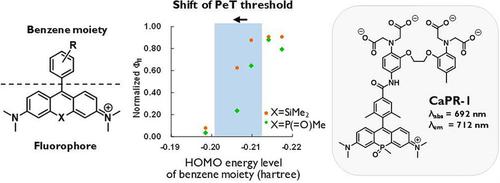当前位置:
X-MOL 学术
›
Chem. Asian J.
›
论文详情
Our official English website, www.x-mol.net, welcomes your
feedback! (Note: you will need to create a separate account there.)
Rational Design of a Near‐infrared Fluorescence Probe for Ca2+ Based on Phosphorus‐substituted Rhodamines Utilizing Photoinduced Electron Transfer
Chemistry - An Asian Journal ( IF 3.5 ) Pub Date : 2020-01-28 , DOI: 10.1002/asia.201901689 Shodai Takahashi 1 , Kenjiro Hanaoka 1 , Yohei Okubo 2 , Honami Echizen 1 , Takayuki Ikeno 1 , Toru Komatsu 1 , Tasuku Ueno 1 , Kenzo Hirose 2 , Masamitsu Iino 3 , Tetsuo Nagano 4 , Yasuteru Urano 1, 5, 6
Chemistry - An Asian Journal ( IF 3.5 ) Pub Date : 2020-01-28 , DOI: 10.1002/asia.201901689 Shodai Takahashi 1 , Kenjiro Hanaoka 1 , Yohei Okubo 2 , Honami Echizen 1 , Takayuki Ikeno 1 , Toru Komatsu 1 , Tasuku Ueno 1 , Kenzo Hirose 2 , Masamitsu Iino 3 , Tetsuo Nagano 4 , Yasuteru Urano 1, 5, 6
Affiliation

|
Fluorescence imaging in the near‐infrared (NIR) region (650–900 nm) is useful for bioimaging because background autofluorescence is low and tissue penetration is high in this range. In addition, NIR fluorescence is useful as a complementary color window to green and red for multicolor imaging. Here, we compared the photoinduced electron transfer (PeT)‐mediated fluorescence quenching of silicon‐ and phosphorus‐substituted rhodamines (SiRs and PRs) in order to guide the development of improved far‐red to NIR fluorescent dyes. The results of density functional theory calculations and photophysical evaluation of a series of newly synthesized PRs confirmed that the fluorescence of PRs was more susceptible than that of SiRs to quenching via PeT. Based on this, we designed and synthesized a NIR fluorescence probe for Ca2+, CaPR‐1, and its membrane‐permeable acetoxymethyl derivative, CaPR‐1 AM, which is distributed to the cytosol, in marked contrast to our previously reported Ca2+ far‐red to NIR fluorescence probe based on the SiR scaffold, CaSiR‐1 AM, which is mainly localized in lysosomes as well as cytosol in living cells. CaPR‐1 showed longer‐wavelength absorption and emission (up to 712 nm) than CaSiR‐1. The new probe was able to image Ca2+ at dendrites and spines in brain slices, and should be a useful tool in neuroscience research.
中文翻译:

基于磷取代的若丹明胺利用光诱导电子转移的Ca2 +近红外荧光探针的合理设计
近红外(NIR)区域(650–900 nm)的荧光成像可用于生物成像,因为在此范围内背景自发荧光低且组织穿透率高。此外,NIR荧光可用作多色成像的绿色和红色的互补色窗口。在这里,我们比较了硅和磷取代的罗丹明(SiRs和PRs)的光诱导电子转移(PeT)介导的荧光猝灭,以指导改进的远红外至NIR荧光染料的开发。一系列新合成的PR的密度泛函理论计算和光物理评估的结果证实,与SiRs相比,PRs的荧光更容易通过PeT猝灭。在此基础上,我们设计并合成了用于Ca 2+的NIR荧光探针,CaPR-1及其膜渗透性乙酰氧甲基衍生物CaPR-1AM分布在细胞质中,这与我们先前报道的基于SiR支架CaSiR-的Ca 2+远红外NIR荧光探针形成鲜明对比1 AM,主要位于溶酶体以及活细胞的胞浆中。CAPR-1显示出更长波长的吸收和发射(高达712纳米)比CaSiR-1 。新的探针能够在脑切片的树突和棘上成像Ca 2+,并且应该是神经科学研究中的有用工具。
更新日期:2020-01-29
中文翻译:

基于磷取代的若丹明胺利用光诱导电子转移的Ca2 +近红外荧光探针的合理设计
近红外(NIR)区域(650–900 nm)的荧光成像可用于生物成像,因为在此范围内背景自发荧光低且组织穿透率高。此外,NIR荧光可用作多色成像的绿色和红色的互补色窗口。在这里,我们比较了硅和磷取代的罗丹明(SiRs和PRs)的光诱导电子转移(PeT)介导的荧光猝灭,以指导改进的远红外至NIR荧光染料的开发。一系列新合成的PR的密度泛函理论计算和光物理评估的结果证实,与SiRs相比,PRs的荧光更容易通过PeT猝灭。在此基础上,我们设计并合成了用于Ca 2+的NIR荧光探针,CaPR-1及其膜渗透性乙酰氧甲基衍生物CaPR-1AM分布在细胞质中,这与我们先前报道的基于SiR支架CaSiR-的Ca 2+远红外NIR荧光探针形成鲜明对比1 AM,主要位于溶酶体以及活细胞的胞浆中。CAPR-1显示出更长波长的吸收和发射(高达712纳米)比CaSiR-1 。新的探针能够在脑切片的树突和棘上成像Ca 2+,并且应该是神经科学研究中的有用工具。











































 京公网安备 11010802027423号
京公网安备 11010802027423号